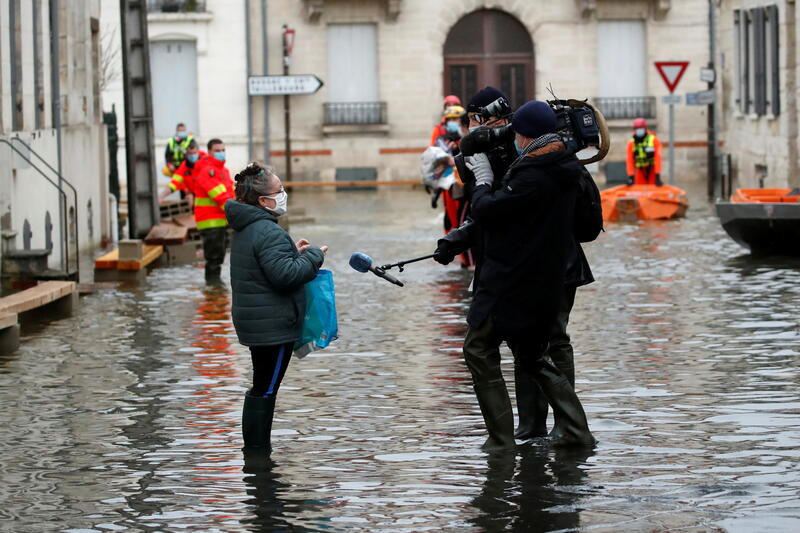Introducing the ‘How To Fix Climate Journalism’ Essay Series

Journalists conduct interviews after the Charente River in Saintes, France overflowed in February 2021. Credit: Stephane Mahe/Reuters
When the Oxford Climate Journalism Network officially began in January 2022, we had very few definitive answers to offer journalists when they asked what would make climate journalism “work.”
We had ideas, of course. We believed that climate journalism in general needs to engage and inform citizens, that it can’t talk “down” to audiences, and that it should be reported on all beats: economics, politics, sports, and culture. We believed that climate journalism needs to scrutinise policymakers and businesses. And we believed it needed to offer something concrete: a real understanding of what climate change means for the future, but also how it is impacting lives right now.
We also believed that climate journalism, and the OCJN, should inherently reflect both the global and local nature of the problem. Global in that brilliant climate coverage should be accessible around the world, particularly in the Global South. And local enough to empower those same journalists to tell climate stories about and for their own communities, using local knowledge and local tools.
And yet, we knew we were ultimately starting a huge experiment into what journalists need to cover climate change well, in vastly different regions and newsrooms. Over the next six months, we would be searching, collectively, for solutions. More than a year later, as our fourth cohort begins, we’re still debating what forms great climate journalism can take, and how to help our audiences feel both informed and empowered.
That said, focusing on solutions can be difficult. What doesn't work, and the barriers in the way, often feel easier to pin down when it comes to climate coverage than what does.
Time and again, across every region of the world, journalists reported that they had trouble getting their own newsrooms interested in the topic, or that they struggled to get engagement from audiences. They often fielded complaints from their colleagues and the public alike that climate coverage is depressing, overly technical—even boring.
Climate stories tended to get bumped down the news agenda by other topics—the war in Ukraine began less than two months into our first cohort—while newsrooms’ resources were frequently constrained. A lack of climate literacy often left the deep links between the environment and other topics unexplored, or even misrepresented. It was a common theme that many journalists felt their commitment to covering climate change was treated as a personal passion, even ‘activism’, rather than a deeply felt duty to inform their audiences about a shift that was already overturning their lives.
And those were just the problems in the newsroom. Many committed journalists are facing harassment or misinformation that undermines their reporting. Many struggle to get climate data from their own governments. Many are covering environmental crime and exploitation, making enemies of powerful political and business forces as a result. The wreckage of extreme weather is leaving many communities in a state of permanent crisis, and the journalists living in those communities are far from immune to the personal toll.
In the face of all these obstacles, how do you keep going?
The practical answer to that question comes in the form of the following essays. Written by journalists around the world, from Poland to Kenya to Colombia to Kyrgyzstan, they provide ideas and real-world inspiration for side-stepping political polarisation, providing context when a hurricane hits, and asking the hard questions when confronted with a wave of “climate finance” jargon.
The writers are members of the OCJN’s first two cohorts over the course of 2022, who have drawn their advice from their own work: whether they’re setting up a network of climate journalists in Ghana, running literacy programs in India, or grappling with the mental toll of covering disasters in the Caribbean. Though their examples are rooted in their personal experience, they hold larger lessons for climate journalists in any country.
In doing so, these essays also offer lessons for journalism of all kinds. Climate change itself is what scientists often refer to as a “super wicked” problem: it is staggeringly complex, bringing together many interrelated issues. But scientists also talk about another phenomenon: the many “co-benefits” that will come with addressing climate change. These aren’t just about survival, but about the chance to create a far safer, cleaner and more equitable world.
Great climate journalism, too, has added benefits. Done well, it’s journalism that addresses audiences in engaging and inventive ways, seeks to side-step rising news avoidance, builds trust, and holds governments and other powerful actors to account. As we saw in the Reuters Institute’s latest Digital News Report, these are problems that the media industry is struggling with nearly across the board. In other words, great climate journalism can offer a roadmap for great journalism of all kinds.
These essays will be published once a week through the coming months. We hope you’ll follow along, and find inspiration, motivation and even solutions for covering climate change—we know we certainly have.




